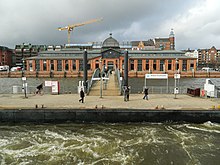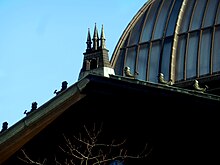Fish auction hall

The fish auction hall in Hamburg-Altona was 1895/96 in Altona at the newly built fishing port at the same built to auction to allow trading and shipping of fish landed there. In addition, the building was used to store and repair fishing gear and to distribute ice . The hall has served as a venue for events since its restoration in 1984. The steel girder construction, filled with brickwork, has been a listed building since 1984 , and testifies to the importance of the fish trade in the formerly competing cities of Hamburg and Altona.
Building history
Since the 16th century, fish markets have been held in the independent Altona on the border with the Hamburg district of St. Pauli against the will of the wealthy Hanseatic city of Hamburg . In the middle of the 19th century, the Hamburg residents moved their fish market from the old town to the suburb of St. Pauli in order to be able to compete with Altona.
The magistrate of Altona, a Prussian city since 1867, opened a new fishing port on the border with Hamburg / St. Pauli building. The associated fish auction hall was built from 1895 to 1896. The costs of acquiring the land and building the facilities and buildings were shared between the city of Altona and the Prussian customs connection fund. The total costs for the first port facility, its expansion and traffic development as well as for the fish auction hall were nearly 3.3 million marks , of which Altona took over a total of 525,000 marks. Of the total costs, about two million marks went to the acquisition of the property, for part of the property the then immense square meter price of 383 marks had to be paid (today about 2,696 euros / m²), which results from the need to demolish inhabited houses. The pure construction costs for the fish auction hall amounted to 320,000 marks, half of which was borne by Altona and the customs connection fund.
architecture
The fish auction hall was built in the style of a three-aisled basilica and should probably be reminiscent of the ancient Roman market halls. Shortly after the construction of the auction hall, the Altona fish market achieved higher sales than the Hamburg one, which then had its own auction hall opposite the Altona company.
Usage history and conversions
In 1934 the two fish market companies in Hamburg and Altona merged to form today's Fischmarkt Hamburg-Altona GmbH. The two auction halls in Altona and St. Pauli were badly damaged in the bombing raids on the city of Hamburg in 1943 and only poorly repaired. The Hamburg auction hall was still used as a film set at the end of the 1960s, but was demolished in 1971 to make room for a planned office and commercial building with high-rise buildings. Today there is a parking lot at the site.
The Altona auction hall faced the same fate. It still served as a warehouse since the operating company had relocated the auctions down the Elbe.
In 1973, Munich theater people together with designers, architects and town planners founded the Volkshaus Fischmarkt e. V. with the aim of re-using the hall as a socio-cultural center with a folk theater, cinema, social services, fish restaurant and beer garden.
The Senate let the initiative develop its conception until 1976, but the hall continued to deteriorate. In 1976, contrary to the plans of parts of the Senate, the association obtained the protection of the hall as a monument by resolution of the Hamburg citizenship . Bodo Schümann (SPD) submitted the application . Thus, the threatened demolition was prevented. The fish auction hall owes its continued existence to the commitment of voluntary citizens.
After further discussions it was decided to restore the Altona fish auction hall and lease it to a commercial user as an event location. The Hamburg architects Günter Talkenberg received the order for the renovation (including the new construction of the dome) and reconstructed the facade decorations and the decorations on the windows based on old black and white photos.
As the only architectural monument in Hamburg, the hall received a europa-nostra diploma in 1984 for outstanding achievements in the field of preserving cultural heritage from the European monument protection association Europa Nostra .
The auction hall was originally intended to be a place of socioculture, but in addition to the hustle and bustle of the fish market, it is mainly used for advertising and PR events by large corporations. The Stacklies company has recently been responsible for catering and events. The hall offers space for around 3500 visitors.
literature
-
J. Brix , M. Musset : The new fishing port and fish market in Altona . In: Zentralblatt der Bauverwaltung , vol. XVI (1896), three parts:
- No. 32 (August 8, 1896), urn : nbn: de: kobv: 109-opus-29632 , pp. 349–350 (part 1),
- No. 33 (August 15, 1896), urn : nbn: de: kobv: 109-opus-29652 , pp. 364–366 (part 2),
- No. 35 (August 29, 1896), urn : nbn: de: kobv: 109-opus-29682 , pp. 390–392 (part 3).
Web links
Individual evidence
- ↑ Monument List of the Free and Hanseatic City of Hamburg , as of April 13, 2010 ( Memento from June 27, 2011 in the Internet Archive ; PDF; 915 kB) Monument Protection Office in the Authority for Culture, Sport and Media, Hamburg 2010, p. 66, Monument List No. . 740
- ↑ J. Brix, M. Musset: The new fishing port and fish market in Altona . In: Zentralblatt der Bauverwaltung , vol. XVI (1896), p. 350.
- ↑ Photo: Altona fish auction hall (foreground) and St. Pauli (in the background on the right) side by side
- ↑ Photo: Fish auction hall St. Pauli hamburger-fotoarchiv.de
- ↑ Photo: Fischauktionshalle St. Pauli, side view hamburger-fotoarchiv.de
Coordinates: 53 ° 32 ′ 41.3 " N , 9 ° 57 ′ 6.4" E






